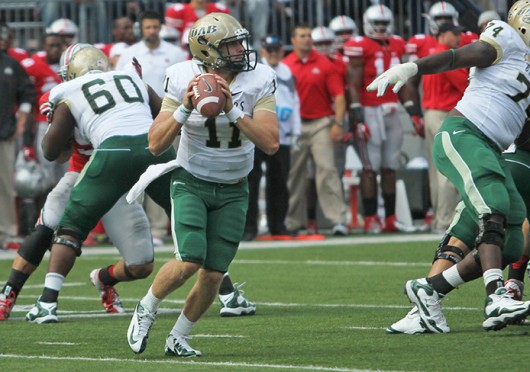
UAB’s Then-redshirt-freshman quarterback Austin Brown (11) scans the field during a 29-15 loss to OSU on Sept. 22, 2012, at Ohio Stadium.
Credit: Lantern file photo
While the Ohio State football team is preparing for a game without its starting quarterback, the University of Alabama-Birmingham is preparing for life without football.
It was announced Tuesday that the university would be shutting down its football program because of financial difficulties, and I could not feel more sympathetic for the players, coaches and fans of the program.
UAB president Ray Watts issued a statement Tuesday that in part said: “As we look at the evolving landscape of NCAA football, we see expenses only continuing to increase. When considering a model that best protects the financial future and prominence of the athletic department, football is simply not sustainable.”
Having played football competitively for eight years (six in grade school, two at the college club level), I can say from personal experience that some of the best memories of my life come from playing the game.
When I played my last football game in November 2013, I was anticipating it. I knew it would be my last game.
The athletes playing for UAB were not so lucky.
For most, their football careers have been ripped away from them, and that is simply not fair.
UAB is not getting shut down because of its performance on the field. This season, for just the second time in the program’s history, the Blazers are bowl eligible under first year head coach Bill Clark.
The team reportedly decided that if invited, it will play in a bowl game, which would mark the final game of the program’s existence.
Just two years ago, the Blazers came into Ohio Stadium and played a Buckeye team that would eventually finish the season undefeated, to a 29-15 final score. The Blazers led for the majority of the first half in that game.
The Blazers have also had 10 players selected in the NFL Draft, including Atlanta Falcons standout wide receiver Roddy White.
Once again, money has taken over the college football landscape and I could not be more disgusted.
Over the years, college football has become about nothing but money. You think Rutgers and Maryland were brought into the Big Ten because of their competitive athletic programs? No offense to the Scarlet Knights and Terps, but that decision was made to bring in the New York and Washington, D.C., television markets which in turn brings in — wait for it — money.
Discussions about paying players have been around for the majority of the last five to 10 years.
While I agree athletes bring in a lot of money for their respective programs, do you think money was on the mind of the UAB football players when they found out the sport they have played for years was stripped away from them? No. Those players, specifically the ones that were seen sobbing after hearing the program will end, played to get an education and to continue playing the game they undoubtedly love.
As a member of OSU’s club football team for most of two years, I can tell you firsthand what it is like to play for the love of the game.
We paid money out of our own pocket to play a season that no one outside of the team really cared about.
We paid for our equipment and travel expenses, amongst other things, to play a game that we all loved.
Just like the UAB players, we did not play in front of large crowds (we probably averaged about 100 people at our games). We did not care about money. We played for the moment. We played because we loved the game.
I wish I could say I knew what the UAB players were going through, but I can’t and few can.
The last Division I program to be discontinued was the University of the Pacific in 1995.
Some players will be able to transfer and continue their football careers, while others will see their athletic careers come to an abrupt halt.
These athletes’ lives have now changed forever, because to those who play it, football is more than a game.
It is a lifestyle.


